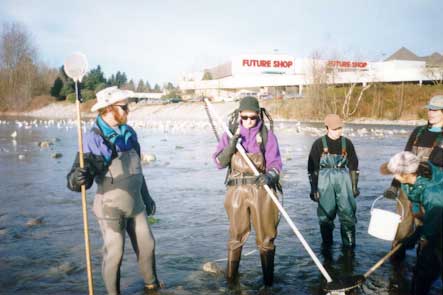
ELECTROFISHING
| An electric current is passed through the water, this current attracts the fish and then stuns them, which makes capture easier. This technique can be done in streams, rivers, or shallow lithorial areas. As the water becomes deeper, it is harder to capture the fish. It is usually done on foot with a backpack, portable shocker device or from a specially modified boat. For streams, side-channels, and shallow margins of a river, a portable backpack is used. Electrofishing works best on terrestrial fish because they hold their ground, schooling fish tend to be scared off. |  |
The equipment for electrofishing includes a portable backpack, power supply, voltage and current regulator, cathode, anode, dip net, and bucket. The crew consists of at least two people, one person is the operator, while another person carries a dip net and a bucket to collect the fish once they have been stunned. The power supply is a 12 v storage battery or either an acid or lightweight gel-cel. In BC, only direct current electroshockers are used because they are less harmful, cause the fish to swim towards the anode, and when the fish gets close, causes narcosis (a state of arrested activity induced by the use of electrical stimulation). The voltage and current regulator adjusts the voltage and current in the water. It also keeps track of the amount of time that the current has been applied to the water. Both the power supply and the regulator are water resistant, and attached to the backpack worn by the operator. The backpack should have a balance switch which turns off the current when the person is not vertical. The cathode is a braided wire cable about 3 m long. The end attached to the backpack is insulated while the end in the water is not and absorbs the electric current. The anode is a fiberglass pole or wand with a metal ring at the end, and fitted with mesh to catch fish. A waterproof "fail" safe switch is attached to the pole, so that when the switch is released, the current stops.
The power switch should be turned on and off because continual application will cause herding behavior in the fish and reduce the efficiency. The output should be adjusted because if it is too low, capture will be poor, but if it is too high, the fish will be injured or killed. The size of the fish present is important because, the larger the fish, the lower the pulse frequency and voltage that should be used.
Electrofishing is done from downstream to upstream, this keeps the disturbed debris from interfering. When the water velocity is high or the fish hard to see, a downstream net should be used to trap missed fish. All team members should wear polarized glasses, so fish and obstacles are easier to see. The anode should be slowly swept through the water from side to side, to draw the fish towards the operator. The seconds shocked, and the area covered in square meters should be recorded. From the seconds shocked, the fishing effort can be found, which is the number of fish caught per unit time. This can then be used to compare to other areas in BC.
© 2009 Veins of Life Watershed Society / All Rights Reserved / if you wish to use any info for commercial or non commercial usage you must obtain permissions from The Veins of Life Watershed Society